Ice fishing can be an incredibly rewarding and serene experience, but one common challenge anglers face is keeping their fishing holes from freezing over. Nothing is more frustrating than constantly having to break through ice, disrupting your fishing and potentially scaring away your catch.
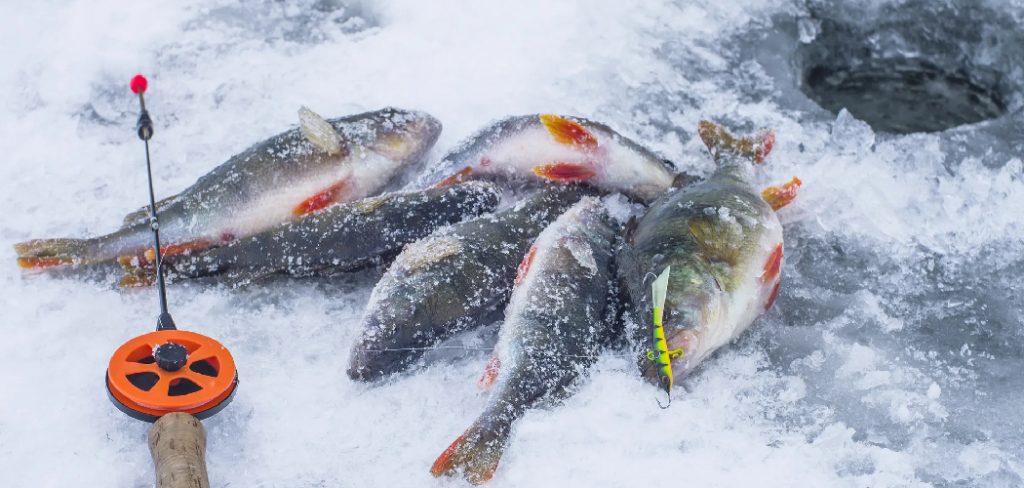
In this guide on how to keep ice fishing holes from freezing, we will explore several effective techniques to ensure your ice fishing holes remain clear and operational, allowing you to enjoy your time on the ice without unnecessary interruptions. Whether you’re a seasoned fisherman or a novice to the sport, these tips and tricks can help you maintain an open hole for longer periods, enhancing your overall ice-fishing experience.
What is Ice Fishing?
Before we dive into the methods of keeping your fishing holes from freezing, let’s briefly discuss what ice fishing is for those who may be unfamiliar with the sport. Ice fishing is a method of angling where individuals fish through openings in frozen bodies of water, typically lakes or ponds. This allows anglers to access areas that would otherwise be unreachable during colder months when water bodies are frozen over.
To successfully catch fish while ice fishing, one must drill a hole in the ice and drop their bait or lure into the water below. The goal is to entice fish to bite by mimicking natural prey movement and ultimately reel them in through the opening in the ice. As you can imagine, it can be quite troublesome if these holes keep freezing over.
Why Do Ice Fishing Holes Freeze?
There are several reasons why ice fishing holes freeze, but the main culprits are cold temperatures and wind. When the air temperature drops below freezing, any exposed water on the surface will also freeze. Additionally, wind can accelerate this process by pushing colder air onto the surface of the water, causing it to freeze faster.
Another factor that contributes to frozen fishing holes is a lack of insulation. Without proper insulation, heat from your body or surrounding environment can escape through the hole, allowing it to freeze more quickly.
Fortunately, there are ways to combat these factors and keep your fishing holes from freezing over so you can focus on catching fish instead of constantly breaking through ice.
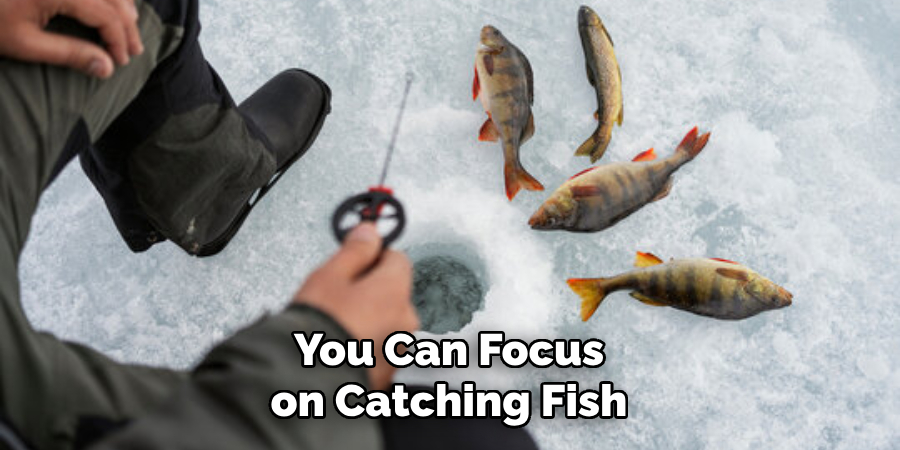
Needed Materials
To effectively keep your ice fishing holes from freezing, you’ll need to gather a few essential materials. Having these items on hand will help you maintain an open and operational hole throughout your fishing session:
Ice Skimmer or Slush Scoop:
This tool is crucial for removing ice and slush from the fishing hole, ensuring it remains clear.
Insulating Hole Cover:
Using an insulating cover over your fishing hole can significantly reduce the rate at which it freezes. These covers trap heat and block wind, keeping the water from solidifying quickly.
Heater or Heat Source:
Portable heaters, such as propane heaters or electric ice-hole heaters, can provide consistent warmth to prevent freezing. Make sure to use these heaters safely and follow all manufacturer guidelines.
Thermally Insulated Bucket or Cooler:
Keeping your bait and other essentials in an insulated container can help maintain their temperature, ensuring they stay effective in attracting fish.
Thermal Tip-Up Line or Line Coating:
Specialized lines or line coatings designed for cold weather can prevent ice build-up on your fishing line, making it easier to manage your setup.
Windbreak or Shelter:
Setting up a windbreak or using an ice fishing tent can shield your fishing area from the wind, slowing down the freezing process.
By having these materials ready and using them effectively, you can minimize the time spent dealing with frozen fishing holes and maximize your time enjoying the ice fishing experience.
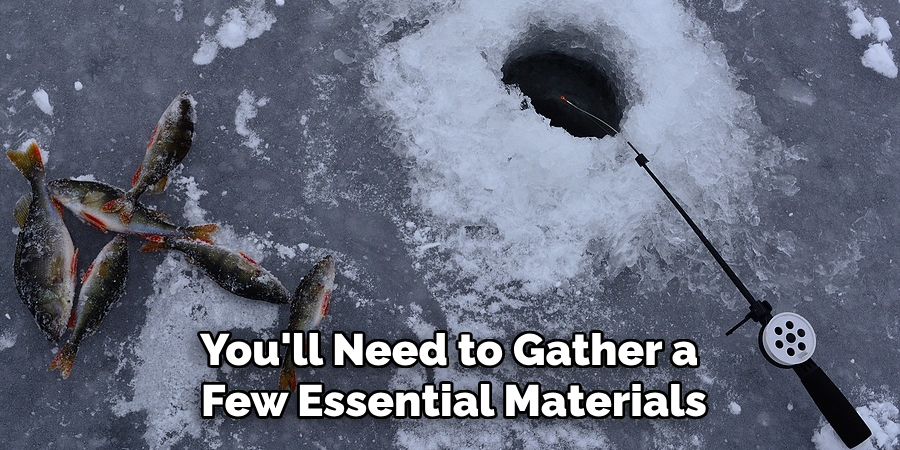
Step-by-step Guidelines on How to Keep Ice Fishing Holes From Freezing
Step 1: Choose a Sheltered Spot
Selecting a sheltered location for your ice fishing hole can significantly reduce the chances of it freezing over quickly. Look for areas that are naturally shielded from the wind, such as near tree lines, rock formations, or artificial windbreaks.
By positioning yourself in a spotless exposed to the elements, you can limit the wind’s impact on your fishing hole, thereby reducing the rate at which the water refreezes. Additionally, setting up an ice fishing tent or portable shelter can provide extra protection from the wind and create a warmer microenvironment around your hole.
Step 2: Insulate Your Hole with a Cover
As mentioned earlier, using an insulating cover over your fishing hole can be highly effective in preventing freezing. These covers come in various forms, such as foam boards or custom-made insulated lids, and are designed to trap heat and block wind from reaching the water’s surface.
When placing the cover over your home, make sure it fits snugly and is secured to prevent it from blowing away. Additionally, avoid stepping on or putting weight on the cover to help maintain its insulation properties.
Step 3: Use a Heater or Heat Source
Employing a heater or heat source is one of the most effective methods to prevent your fishing hole from freezing. There are several options available, such as propane heaters, electric ice-hole heaters, or small portable heat units. Propane heaters are particularly popular among ice fishermen due to their portability and efficiency in generating consistent warmth.
To use a heater effectively, place it near the edge of your fishing hole, ensuring it is stable and positioned safely to avoid any contact with water. It’s essential to follow the manufacturer’s instructions and maintain a safe distance from flammable materials. Additionally, consider using a portable heat reflector to direct the warmth towards the ice hole, maximizing the heater’s efficiency.
Regularly check the heater to ensure it is functioning correctly and to replenish fuel if necessary. By consistently providing a source of warmth, you can significantly reduce the risk of your fishing hole freezing over, allowing you to focus more on your fishing and less on breaking through ice.
Step 4: Keep Your Bait and Essentials Insulated
Keeping your bait, lures, and other essentials in a thermally insulated container can help maintain their temperature and effectiveness. A cooler or bucket with insulating properties is ideal for this purpose and can prevent them from freezing over quickly.
It’s essential to keep these containers as close to your fishing hole as possible, minimizing the amount of time they are exposed to colder temperatures. Additionally, consider using bait designed specifically for cold weather conditions. These baits tend to be more durable and effective in attracting fish in low temperatures.
Step 5: Clear the Hole Regularly
Regularly clearing your fishing hole of ice and slush is crucial in preventing it from freezing over completely. Periodically, use an ice skimmer or slush scoop to remove any accumulated ice and slush that forms on the surface. This process not only helps maintain a clear and open fishing hole but also ensures that your fishing line can move freely without getting snagged.
To effectively clear the hole, make it a routine to check and scoop out ice every 15 to 30 minutes, depending on the severity of the weather conditions. Consistent maintenance will keep the hole from icing up and make it easier for you to manage your fishing setup. Additionally, clearing the hole allows for better oxygen exchange in the water, which can attract more fish to your location.
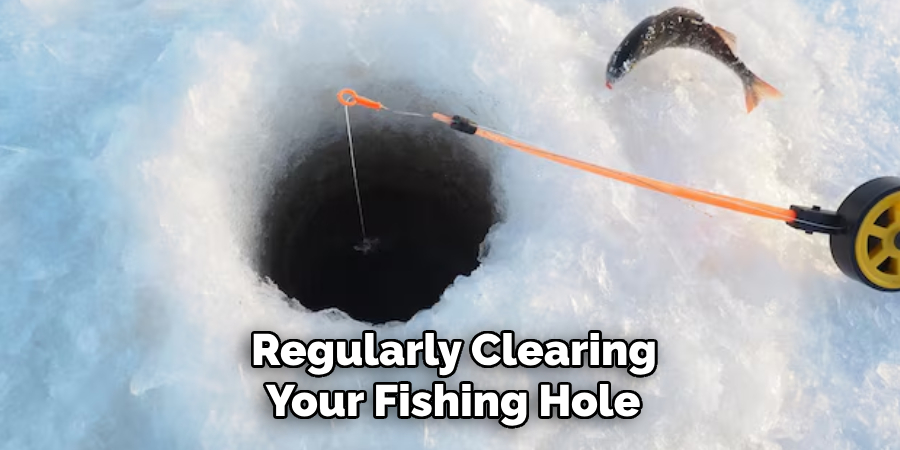
By incorporating regular clearing into your ice fishing routine, you can ensure a more productive and enjoyable fishing experience without the continual hassle of dealing with a frozen fishing hole.
Step 6: Use a Thermal Tip-Up Line or Coating
Specialized lines or line coatings designed for cold weather can be highly effective in preventing ice buildup on your fishing line. These products are specifically engineered to reduce friction and repel water, making it easier to manage your setup.
Thermal tip-up lines have a built-in heating element that prevents the line from freezing and ensures it stays pliable and tangle-free. Alternatively, using a liquid line coating can provide similar effects by creating a hydrophobic barrier on the surface of the line.
Whichever option you choose, applying these products before setting up your fishing line can significantly reduce the risk of ice buildup and make it easier to manage your gear.
Step 7: Stay Active and Agitate the Water
Staying active around your fishing hole can help prevent freezing by agitating the water’s surface. Continuously moving or walking around your fishing area can create a disturbance in the water, preventing it from settling into a still state that promotes faster freezing.
Additionally, using an ice auger to drill multiple holes around your main fishing hole can also create more movement and increase oxygen exchange in the water. This technique is particularly useful when targeting larger fish species that require a broader area to feed.
Step 8: Consider Using Wind Chimes or Noise Makers
Similar to staying active, using wind chimes or noise makers near your fishing setup can keep the water surface from freezing over due to constant vibrations. These items can be easily attached to your shelter or nearby trees, creating a subtle disturbance that can help prevent ice formation.
Be mindful of the noise level and choose quieter options to avoid scaring away fish. Using wind chimes or noisemakers in combination with other techniques mentioned above can provide added protection against freezing and increase your chances of catching more fish.
Following the steps on how to keep ice fishing holes from freezing outlined above can significantly improve your chances of preventing a frozen fishing hole and make your ice fishing experience more comfortable and productive. However, it’s essential to always prioritize safety when implementing these techniques and regularly check weather condition updates before heading out on the ice. Stay warm, stay safe, and happy fishing!
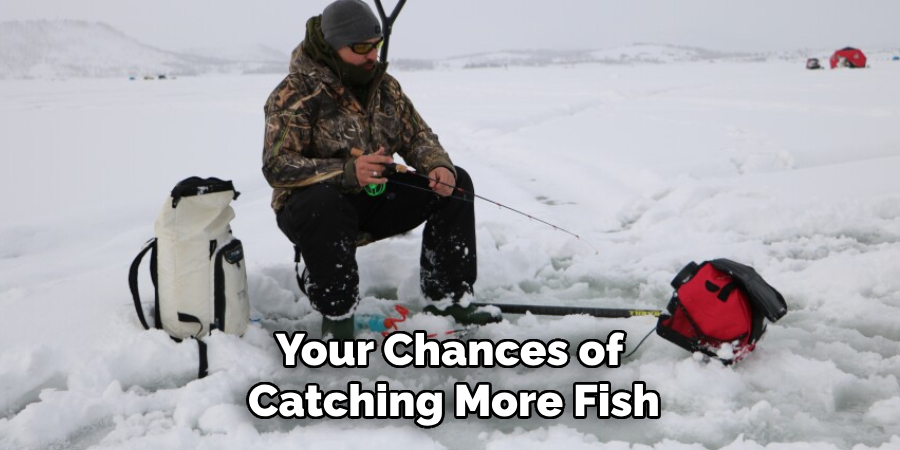
Seasonal Considerations
When planning your ice fishing trip, it’s crucial to take seasonal variations and local climate conditions into account. Different seasons offer unique challenges and opportunities that can significantly impact your fishing experience.
Early Winter
In the early winter months, ice formation is still in its initial stages, and ice thickness can be quite variable. Always check ice conditions before heading out and ensure that it is at least 4 inches thick for safe walking. During this period, fish are often more active as they adjust to the colder temperatures, making it a great time to target various species. However, be prepared for rapidly changing ice conditions and take extra precautions to ensure your safety.
Mid-Winter
Mid-winter typically provides the most stable ice conditions, with thicker and more reliable ice cover. This is often considered the peak season for ice fishing, as fish settle into consistent patterns that can be easier to predict. During these months, you’ll often face harsher weather conditions, so ensure you have adequate clothing and gear to stay warm. The use of shelters and heaters becomes even more essential to maintain comfort and safety on the ice.
Late Winter
As winter begins to wane, ice conditions can start to deteriorate, especially in regions experiencing milder temperatures. Thawing and refreezing cycles can create deceptive ice surfaces, and caution is paramount. Fish can become more active again as they prepare for the spring spawning season, offering excellent opportunities for those willing to brave the changing conditions. Keep a close eye on weather forecasts and be prepared for potential hazards like thin ice and water pooling on the ice’s surface.
By considering these seasonal factors and adapting your strategies accordingly, you can optimize your ice fishing efforts and ensure a safer, more successful outing.
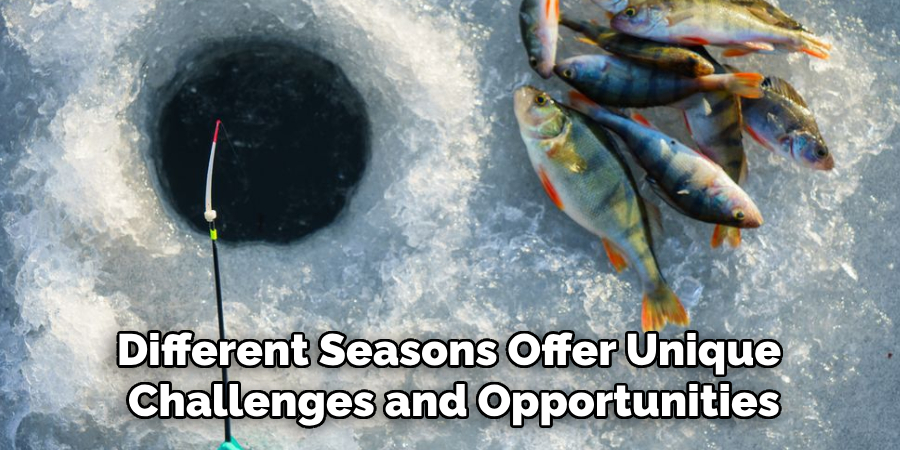
Safety and Environmental Impact Considerations
While ice fishing can be an enjoyable and rewarding experience, it’s crucial to prioritize safety and minimize your environmental impact when out on the ice. Here are some essential tips to keep in mind:
- Always check local weather conditions before heading out and avoid areas with thin or unstable ice.
- Make sure to have the necessary safety equipment, including a life jacket, ice picks, and a rope for emergency situations.
- Respect fishing regulations and limits to ensure sustainable fish populations for years to come.
- Properly dispose of any waste or debris generated during your trip to help keep the environment clean.
- Be conscious of noise levels and try not to disturb wildlife or other fishermen in the area.
By following these guidelines, you can help ensure both your safety and the preservation of natural resources for future generations to enjoy. Ice fishing is a unique winter activity that offers an incredible opportunity to connect with nature and experience the thrill of catching fish on a frozen lake. Implementing proper techniques and precautions
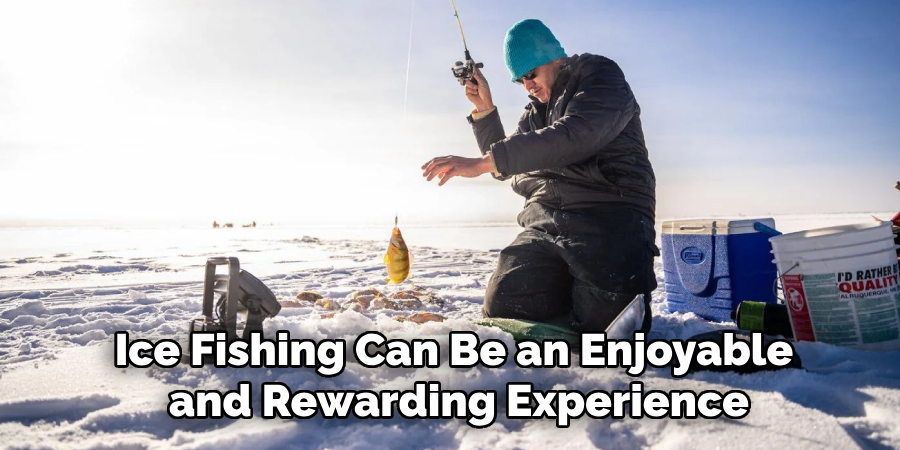
Frequently Asked Questions
Q: Can I Still Go Ice Fishing if There Are Signs of Ice Formation on the Surface?
A: It’s always recommended to check local weather and safety conditions before heading out on the ice. If there are signs of early ice formation, it’s best to wait for the ice to thicken before venturing out. Depending on the weather and location, this can take anywhere from a few days to a week or more. It’s essential never to underestimate the thickness and stability of the ice.
Q: Do I Need Specialized Equipment for Ice Fishing?
A: Yes, specialized equipment such as an ice auger, shelter/tent, sleds, heaters, and insulated gear are necessary for safe and productive ice fishing. Regular fishing gear may not be suitable for use in icy conditions and can result in injury or damage.
Q: Can I Use Regular Bait for Ice Fishing?
A: While regular bait can be used for ice fishing, it’s recommended to use bait designed specifically for cold weather conditions. These baits tend to be more durable and effective in attracting fish in low temperatures. Additionally, using specialized bait can help prevent it from freezing over quickly.
Q: How Thick Should the Ice Be Before I Can Safely Go Ice Fishing?
A: The recommended minimum ice thickness for safe ice fishing is four inches of solid clear ice. However, this can vary based on location and weather conditions. It’s always essential to check local guidelines and recommendations before venturing out onto the ice.
Q: What Should I Do If My Fishing Hole Freezes Over Completely?
A: If your fishing hole freezes over completely, you can use an ice auger or shovel to create a new hole nearby. Alternatively, you can use a chisel to break up the ice and create a small opening for fishing. Be sure to check local guidelines on how many holes are allowed in your specific location. So, always be prepared with the necessary tools and equipment before heading out on the ice.
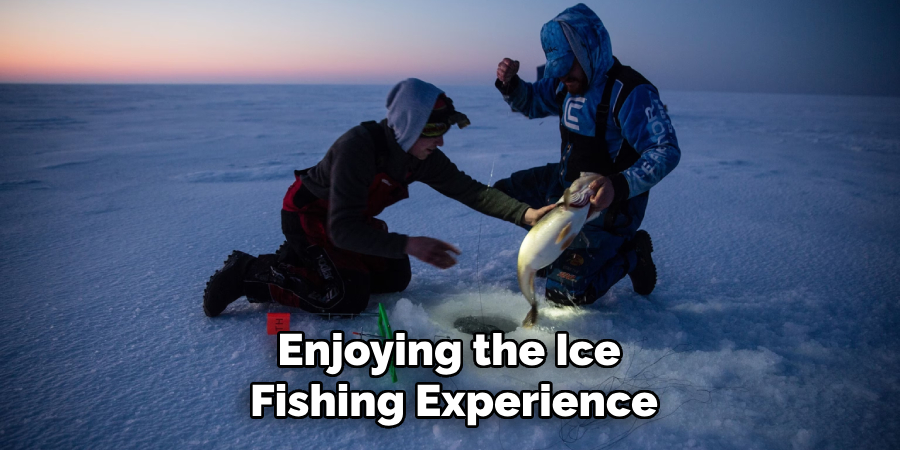
Conclusion
By following these comprehensive steps on how to keep ice fishing holes from freezing, you can effectively prevent your fishing hole from freezing over, ensuring a smoother and more enjoyable ice fishing experience. Whether employing heaters, using insulated containers, or staying active around your fishing site, each method plays a crucial role in combating the harsh winter elements.
Additionally, specialized equipment like thermal tip-up lines and accessories such as wind chimes can add significant advantages to your setup. Always remember to prioritize safety, take necessary precautions, and check the latest weather updates. With these preparations, you can focus more on the thrill of catching fish rather than battling the ice. Stay warm, stay safe, and enjoy your ice fishing adventures!
About the Author
Jennifer Branett is the author of Fishy Kayak and an expert in fish-related fields, with over 10 years of experience. Her work blends passion for fishing with a commitment to conservation.
Educational Background
Degree: Bachelor’s in Marine Biology
Institution: University of California, Santa Barbara
Specializations: Aquatic ecosystems, fish behavior, and sustainable practices
Professional Experience
Conservation Projects:
Collaborated with local organizations to restore aquatic habitats
Developed educational programs on sustainable fishing practices
Publications:
Authored articles for fishing magazines and environmental journals
Featured speaker at fishing expos and conservation conferences
Key Areas of Expertise
Fishing Techniques:
Kayak fishing strategies
Freshwater and saltwater fishing methods
Environmental Stewardship:
Advocacy for sustainable fishing
Promoting biodiversity in aquatic environments
Awards and Recognition
Recipient of the [Specific Award Name] for contributions to marine conservation
Recognized as a leading voice in the fishing community by [Organization/Publication Name]
Community Engagement
Workshops and Seminars:
Regularly hosts events to educate anglers on sustainable practices
Engages with youth programs to inspire the next generation of fishers
Online Presence:
Maintains an active blog sharing tips, stories, and conservation efforts
Engages with followers on social media to promote fishing ethics
Personal Interests
Enjoys kayaking in scenic locations
Passionate about photography, capturing the beauty of nature
Advocates for local conservation efforts in her community
